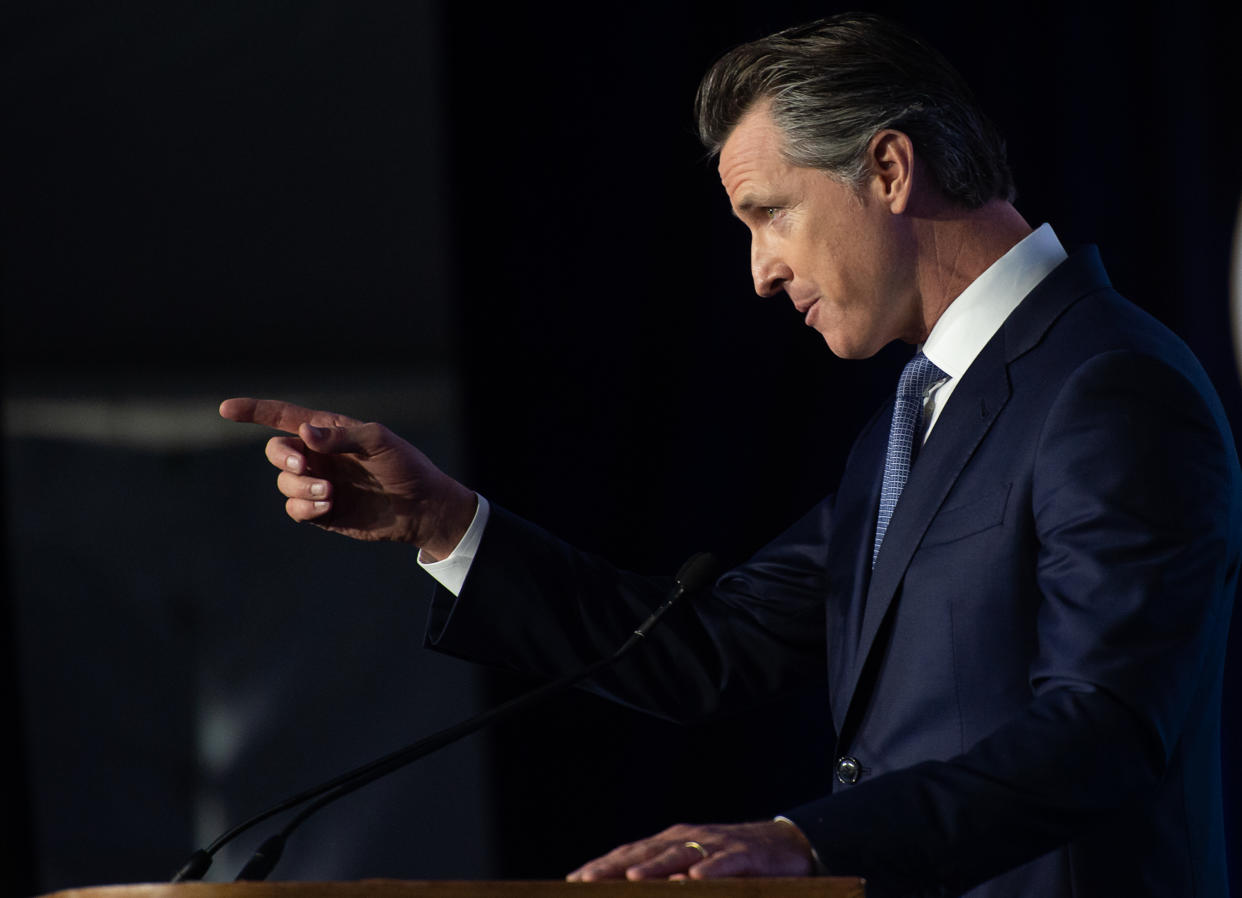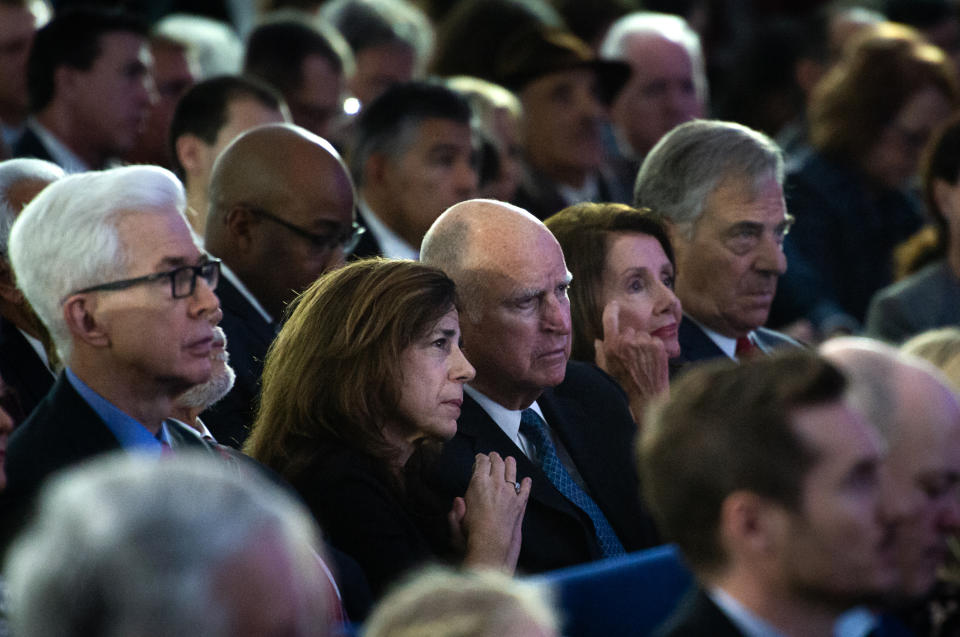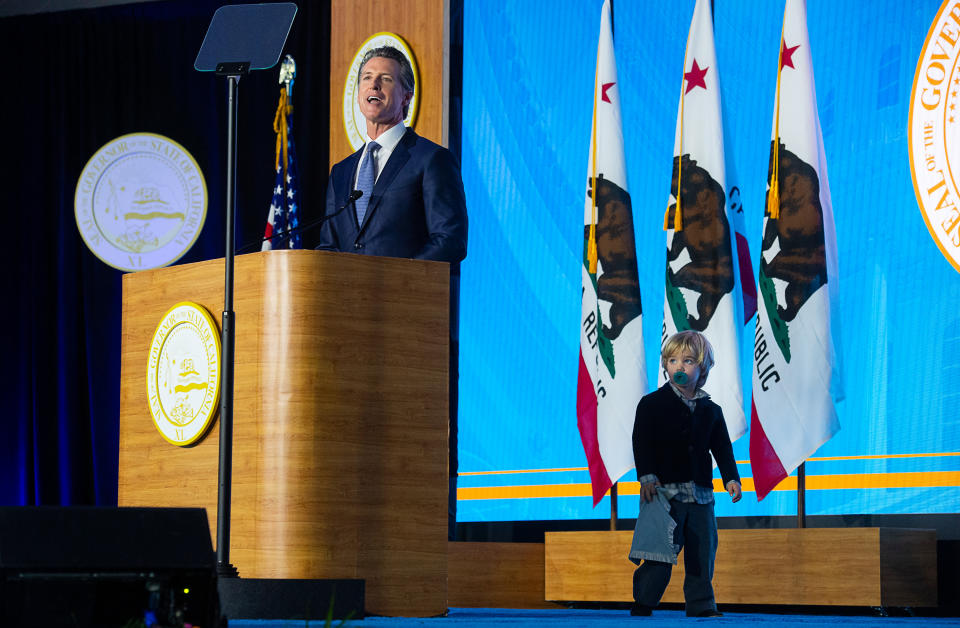Gavin Newsom sets a bold — and costly — agenda for California, staking the future of his party on its success

California’s new governor has a message for his fellow Democrats, not only in the Golden State but across the country:
Don’t like what’s happening in Donald Trump’s Washington, D.C.? Then watch what I’m about to do.
Under a huge tent shielding thousands of guests from looming rainclouds, Gavin Newsom mounted the stage in Sacramento Monday to take his oath of office and deliver an inaugural address.
It was an afternoon rich in symbolism: a passing of the generational torch from four-term Gov. Jerry Brown, a curmudgeonly, childless octogenarian, to a 51-year-old former wine entrepreneur and San Francisco mayor with four young kids. It was also a reversal of Brown’s blunt, even bleak, mantra of austerity — eight years ago he celebrated his own inauguration by eating a hot dog — to a flashier form of leadership. Newsom hosted a concert with Common and Pitbull instead.
But amid all the grandstanding and rhetoric, the moment marked a more practical shift as well. Always a lone wolf, Brown never really aspired to stand for something larger than his own idiosyncrasies. Newsom, in contrast, premised his entire campaign on the idea that California, home to the world’s fifth-largest economy, more people than any other state and a powerless GOP, should be the model alternative to Trump’s Washington, a place where progressive solutions to America’s most pressing problems, from income inequality to education to health care, can be successfully implemented on an unmatched scale.
It was a theme Newsom made sure to emphasize in Monday’s speech.
“California has always helped write America’s future, and we know the decisions we make would be important at any time,” he said. “But what we do today is even more consequential because of what’s happening in our country. People’s lives, freedom, security, the water we drink, the air we breathe — they all hang in the balance. The country is watching us. The world is waiting on us. The future depends on us. And we will seize this moment.”
In the weeks and months ahead, this ambitious notion of California as a prototype for the rest of the nation will embody both the promise and the potential pitfalls of Newsom’s nascent governorship.
The promise part is simple. While newly empowered House Democrats still have to contend with President Trump and a Republican Senate, Newsom will enjoy legislative supermajorities, an estimated $14.8 billion budget surplus and a projected $14.5 billion rainy-day reserve fund.

These advantages could, in turn, help him keep his long list of campaign promises, which together represent one of the largest government expansions California has ever seriously contemplated: a statewide single-payer health care system; universal preschool; 3.5 million new housing units by 2025; an energy grid run solely on renewables; and a state bank dedicated to financing infrastructure projects, small businesses and a burgeoning marijuana industry.
If passed, Newsom’s agenda would provide many rank-and-file Democrats with exactly what they’ve been craving: a real-world example of progressive governance that can transcend the stalemate on Capitol Hill as well as the tired internal debates between Bernie bros and Hillarybots, populism and identity politics.
But that’s a big if.
The danger for Newsom (and for the Democrats rooting for him) is that the last time California was a national symbol of anything, it was as a failure of progressive governance. Before Brown took office, in the teeth of the Great Recession, California was $27 billion in debt, with the worst credit rating of any state in the nation, and unemployment hovered above 12 percent.
It’s debatable how much blame Sacramento deserved; with its disproportionate reliance on tax revenues from über-wealthy coastal types, recessions always hit California especially hard. But that didn’t stop national conservatives, and eventually the media at large, from lampooning the state as “the next Greece” — a liberal fantasyland that had spent its way to the brink of collapse. And it won’t stop the next recession from having a similarly outsize effect on California’s fortunes.
“The more money you have, the better you feel,” explains Brown, who devoted much of the last few years to vetoing costly Democratic legislation and stockpiling reserves for the recession he frequently predicts is coming. “The better you feel, the more you spend. But at that very moment, you should have stopped.”
Already, in the earliest days of their new term, California legislators have proposed $40 billion in new spending, and Newsom himself has floated a plan to extend the state’s paid family leave program from six weeks to six months for all California residents — the most generous policy in the nation. What Newsom has not floated, at least not yet, is a sustainable way to pay for such an extension.
Meanwhile, in his inaugural address, the new governor did not seem particularly inclined to lower his sights. He pledged to launch a “Marshall Plan for affordable housing”; to provide “sanctuary to all who seek it”; to ensure “fair pay” for “working people”; and to offer “guaranteed health care for all Californians.” Within hours, Newsom was on Facebook, directing state officials to set up the nation’s largest single-purchaser system for prescription drugs and revealing that his budget, to be unveiled in full later this week, would reinstate Obamacare’s individual mandate and increase subsidies for families making as much as $150,000. He also said he would ask the legislature to allow all undocumented immigrants under 26 to participate in the state’s Medicaid plan.

At other times, Newsom has acknowledged the need for fiscal restraint, citing the previous administration as a model. He has tempered his calls for a single-payer system, for instance, pivoting to the phrase “guaranteed health care” instead. “I haven’t budged in terms of being someone who believes in fiscal discipline,” he told Yahoo News last summer.
But when the idea of that sort of discipline came up in Monday’s speech, he immediately undercut it by insisting he would be “bold” at the same time. “We will prepare for uncertain times ahead,” Newsom said. “We will be prudent stewards of taxpayer dollars, pay down debt and meet our future obligations. And we will build and safeguard the largest fiscal reserve of any state in American history.
“But let me be clear,” Newsom continued, “we will be bold. We will aim high and we will work like hell to get there.”
How deftly Newsom navigates the dangerous space between those sentences will define his governorship — and shape the future of his party. “Bold” is the latest liberal buzzword; every Democrat, both in Washington and on the 2020 campaign trail, is saying it. But few besides Newsom actually have the opportunity to govern boldly. The question is how bold he can afford to be. If a Democrat like Newsom can’t deliver in a place like California, at a moment like this, then it will be hard for Democrats as a whole to argue that they can deliver nationwide.
The pressure, in other words, is on. Newsom’s success or failure will set the parameters of what is possible for his party — and resonate far beyond California’s borders.
_____
Read more from Yahoo News:



